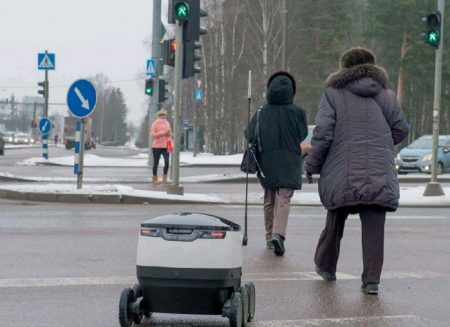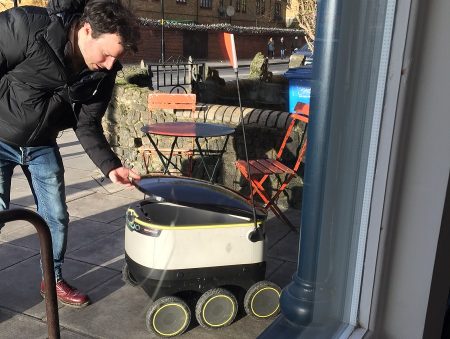February 25, 2017 – The first prototype delivery robot from Starship Technologies, a company with offices in Tallinn, London, UK, and Redwood City, California. Launched in 2014, the company is in the business of revolutionizing local delivery using smart six-wheeled robots. The developers have pretty significant credentials in the software world, having been co-founders of Skype, the communication technology that Microsoft acquired a few years ago.
Resembling a small buggy, the Starship robot comes with speakers and microphones. Trundling along at 6 kilometers (about 3.7 miles) per hour the robot is easily seen by pedestrians as it rolls along.

How does it work?
The robot is designed to navigate city streets and recognize conventional traffic lights. It has onboard computer vision (9 cameras including 3 stereo pairs), ultrasonic sensors, and GPS to pinpoint location to the nearest 2 centimeters (less than an inch). The robot builds a 3D map of its neighbourhood within the limits of its operating range and battery power, approximately 5 kilometers (3 miles) and 2.5 hours. It recognizes red and green lights. If it comes to one that requires button activation, the onboard microphone and speakers allow it to ask for assistance from any pedestrian nearby that it sees.
In Tallinn, the robot is undergoing a good test delivering orders from three restaurants. Eventually, the plan is to use it as a courier for over 120 eateries in the city. Tallinn isn’t the only place where one can see it trundling along city streets. So far tests have occurred in 56 cities, 16 countries, with the robots traveling 16,000 kilometers (10,000 miles) and encountering 1.7 million people en route.
How does a delivery done by a Starship differ from using a human courier on a bicycle, or scooter or in a car? The robot is software controlled. It works with an integrated smartphone application that customers can download for ordering from participating restaurants. The restaurants make the meals and summon a Starship. When it arrives the restaurant places the order in the Starship’s secured compartment. The robot has the navigation coordinates from the mobile app information shared by the customer. It has onboard navigation maps and computer vision to allow it to find its way. With its six-wheel configuration, it can even climb 20-centimeter (7.8-inch) steps, so most stairs are not a problem. Upon arriving at its destination, the robot messages the customer to come out to get his or her meal. Included in the message is a security passcode which the customer then uses to unlock the compartment to retrieve the meal.

The Starship’s specifications:
- Empty weight – 18 kilograms (just under 40 pounds)
- Payload – up to 10 kilograms (22 pounds) or 3 shopping bags
- Top speed – 16 kilometers (10 miles) per hour although the current model is limited to 6 kilometers (3.7 miles) per hour
- Braking distance – 30 centimeters (less than one foot)
- Range time – 2 to 2.5 hours
- Range distance – an area about 6 kilometers (3.7 miles) in radius
- Battery Power – 50 watts
- Length – 68 centimeters (27 inches)
- Height – 55 centimeters (22 inches)
- Width – 55 centimeters (22 inches)
Currently, there are 50 Starship robots out there in cities across the globe. One may soon be operating in yours. The developers note that encounters with humans have been, for the most part, highly favourable. No one has tried to steal a Starship, 30% of the people who encounter one have an “overwhelmingly positive” reaction, while the rest hardly pay attention.










